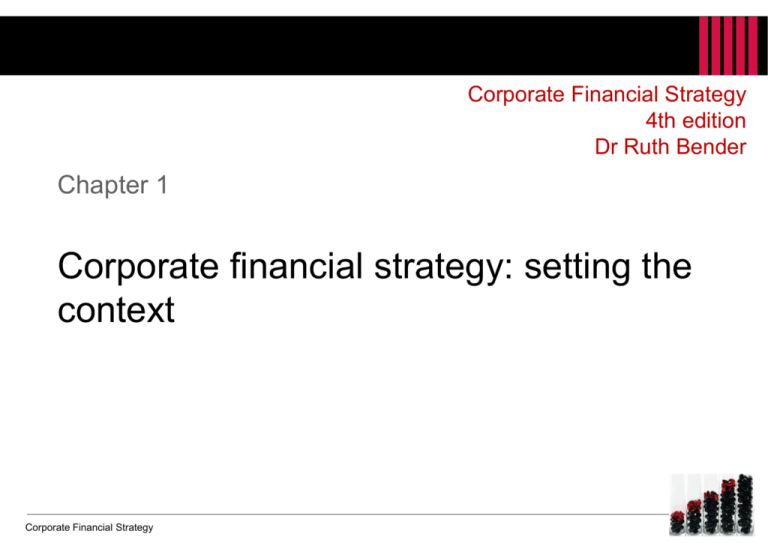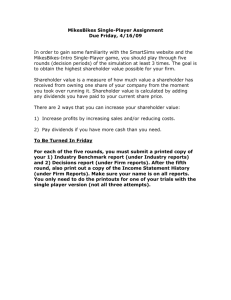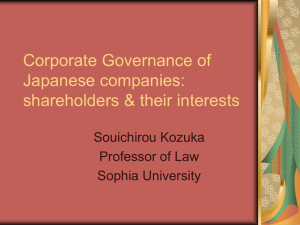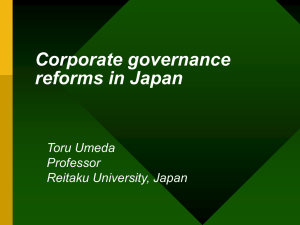Creating Shareholder Value
advertisement

Corporate Financial Strategy 4th edition Dr Ruth Bender Chapter 1 Corporate financial strategy: setting the context Corporate Financial Strategy Setting the context: contents Learning objectives Risk and return The two-stage investment process What does ‘good’ look like? NPV illustration (Working Insight 1.3) Value is created ‘above the line’ (Figure 1.4) Individuals have different risk appetites (Figure 1.5) The seven drivers of value Economic profit (Working Insight 1.5) Total shareholder return (Working Insight 1.6) The value matrix (Figure 1.6) Stakeholders are important Agency and double agency Corporate Financial Strategy 2 Learning objectives 1. Understand what financial strategy is, and how it can add value. 2. Explain why shareholder value is created by investments with a positive net present value. 3. Appreciate how the relationship between perceived risk and required return governs companies and investors. 4. Differentiate the different models of measuring shareholder value. 5. Explain why share price is not necessarily a good proxy for company value. 6. Outline how agency theory is relevant to corporate finance. Corporate Financial Strategy 3 Risk and return Required return Perceived risk Corporate Financial Strategy 4 The two-stage investment process Shareholders (and others) invest in the company Company invests in a portfolio of projects Corporate Financial Strategy 5 What does ‘good’ look like? Is it a good Is it a good Product? Product? Is it a good Business ? Is it a good Company ? Is it a good Investment? Corporate Financial Strategy 6 Value is created above the line Required return Increase return more than risk X Reduce risk more than return Perceived risk Corporate Financial Strategy 7 Individuals have different risk appetites Required return Longserving manager Venture capital fund Welldiversified institutional investor Perceived risk Corporate Financial Strategy 8 The seven drivers of value 1. Increase sales growth More profit 2. Increase operating profit margin 3. Reduce cash tax rate Out of fewer assets 4. Reduce working capital as % of sales At lower risk 6. Reduce weighted average cost of capital For as long as possible 7. Increase timescale of competitive advantage 5. Reduce fixed assets as % of sales Rappaport, Creating Shareholder Value, 1998 Corporate Financial Strategy 9 Economic profit Operating profit after tax Capital employed Cost of capital £2,400 £20,000 10% Operating profit after tax 2,400 less cost of capital (20,000 x 10%) 2,000 Economic profit 400 Return on capital employed (2,400/20000) Spread 2% Economic profit (2% x 20,000) Corporate Financial Strategy 12% 400 10 Total Shareholder Return (TSR) Share price at 1 January Share price at 31 December 100 110 Capital gain in the year Dividend paid in the year 10 5 Total return 15 Total shareholder return (TSR) 15% Corporate Financial Strategy 11 Figure 1.5 The value matrix > 1.0 Value multiple Market value ÷ Fair value = 1.0 < 1.0 Negative Corporate Financial Strategy Economic profit 12 Positive Stakeholders are important Shareholders Investment institutions, family members, prospective investors Community Local community, environmental bodies, public at large Debt holders Banks, investment institutions, individuals Customers Direct customers, end consumers, consumer groups Business and Financial strategy Managers Board of directors, senior managers, other managers Government and regulators Tax authorities, trade department, employment department, governance regulators Employees Individuals, unions / staff associations, pensioners Corporate Financial Strategy Suppliers Long term suppliers, raw material suppliers, sub-contractors 13 Agency and double agency Net assets Debt Fixed assets Current assets less current liabilities Non-operating assets Fund managers Equity Management Employees Corporate Financial Strategy 14 Individual shareholders and pensioners











